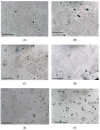Dry but Not Humid Thermal Processing of Aloe vera Gel Promotes Cytotoxicity on Human Intestinal Cells HT-29
- PMID: 35267378
- PMCID: PMC8909460
- DOI: 10.3390/foods11050745
Dry but Not Humid Thermal Processing of Aloe vera Gel Promotes Cytotoxicity on Human Intestinal Cells HT-29
Abstract
Aloe vera products, both in food and cosmetics, are becoming increasingly popular due to their claimed beneficial effects, which are mainly attributed to the active compound acemannan. Usually, these end products are based on powdered starting materials. High temperatures during the drying process to obtain the starting materials have several advantages, like shortening the drying time, eliminating toxic aloin and reducing bacterial contamination. Nevertheless, there are two major drawbacks: first, at temperatures of 80 °C or higher, structural changes in acemannan, especially its deacetylation (>46%), are triggered, which does not happen at lower temperatures (14% at 60 °C); secondly, a toxic principle is formed at higher temperatures, resulting in a higher cytotoxicity. Thus, two temperature-dependent but opposing effects cause with a median cytotoxic concentration of CC50 = 0.4× a peak of cytotoxicity at 80 °C; at 60 °C this cytotoxic substance is not formed and at 100 °C aloin is more readily eliminated, resulting in a CC50 = 1.1× and CC50 = 1.4×, respectively. The cytotoxic substance generated by dry heat at 80 °C is not a modified polysaccharide because its polysaccharide-enriched alcohol-insoluble fraction is with CC50 = 0.9× less cytotoxic. Moreover, this substance is polar enough to be washed away with ethanol. Additionally, when Aloe gel is heated at 80 °C under humid conditions (pasteurization), the cytotoxicity does not increase (CC50 = 1.6×). Finally, to produce powdered starting materials from Aloe gel, it is recommended to use temperatures of around 60 °C in order to preserve the acemannan structure (and thus biological activity) and the low cytotoxicity.
Keywords: Aloe vera; acemannan; acetylation; cytotoxicity.
Conflict of interest statement
The authors declare no conflict of interest.
Figures





References
-
- Upton R., Axentiev P. Standards of Identity, Analysis and Quality Control. 1st ed. American Herbal Pharmacopoeia; Scotts Valley, CA, USA: 2012. Aloe vera leaf, Aloe vera leaf juice, Aloe vera inner leaf juice; pp. 1–55.
-
- Femenia A., Sánchez E.S., Simal S., Rosselló C. Compositional features of polysaccharides from Aloe vera (Aloe barbadensis Miller) plant tissues. Carbohydr. Polym. 1999;39:109–117. doi: 10.1016/S0144-8617(98)00163-5. - DOI
Grants and funding
LinkOut - more resources
Full Text Sources

